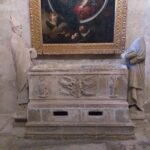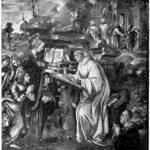St. Saturninus
St. Saturninus
When they lived:
Saint Saturninus is believed to have lived during the 3rd century, precisely in the 3rd and 4th decades AD, in the city of Toulouse, which is now in modern-day France.
Where they lived:
Saint Saturninus spent the majority of his life in Toulouse, a bustling Roman city located in the southern part of France. During his time, Toulouse was known for its vibrant culture and was an essential center for trade and commerce in the region.
Notable world events during the time of their life:
- Diocletian’s Persecution (303-311 AD): Saint Saturninus lived during the height of the Diocletianic Persecution, one of the most severe and widespread persecutions of Christians in the Roman Empire. This event had a profound impact on the early Christian community and likely influenced Saint Saturninus’ own life and mission.
- Roman Empire Division (284-395 AD): The Roman Empire underwent significant political changes during Saint Saturninus’ time, with the empire being divided into the Eastern and Western Roman Empires. This division had far-reaching consequences for the spread of Christianity and the role of bishops like Saint Saturninus.
- Galen’s Medical Contributions (2nd century AD): Though Galen lived before Saint Saturninus, his medical teachings and discoveries greatly influenced the state of medicine during this era. This scientific progress would have indirectly affected the health and well-being of people in Toulouse, including the early Christians whom Saint Saturninus ministered to.
- Spread of Christianity: Saint Saturninus lived during a period when Christianity was rapidly spreading throughout the Roman Empire. His own missionary work in Toulouse contributed to the growth of the Christian faith in the region, making it a notable event in the context of early Christian history.
Their patronage:
Saint Saturninus is the patron saint of Toulouse, France, and his story is deeply interwoven with the city’s history and culture. He is also the patron saint of vineyards, celebrating the rich tradition of winemaking in the region. Saint Saturninus’ association with vineyards and wine can be quite intriguing, as it connects the spiritual and cultural aspects of life in Toulouse.
The Early Life of St. Saturninus
According to the lost acts of the saint, he was the son of Aegeus, King of Achaea, and Cassandra. His birth was in Patras, Greece, around the 3rd century.
Much isn’t known about his childhood, but he was clearly from a royal lineage as his father was a king, and his mother before marriage was the daughter of Ptolemy, King of the Ninevites.
Bishopric of St. Saturninus
St. Saturninus was one of the seven bishops sent out by St. Fabian at a time when persecutions of Christians were very high and the small Christian communities had all but dissolved.
Assumed to be the first bishop of Toulouse, St. Saturninus soon arrived in Toulouse, where he was able to build a small church community. His church community was located some distance from where the pagan priests worshipped and received oracular messages.
It is recorded that his presence there caused the pagan gods to be upset, so the priests no longer received messages from them.
Works of St. Saturninus
The only records of his works are the lost acts of Saturninus. But while he served as a bishop, he was able to convert many pagans, including the farmer who joined him as a missionary, known as St. Honestus.
He also served as a missionary to Gaul, the Pyrenees, and the Iberian Peninsula. St. Saturninus teamed with St. Martial, and together, they were able to perform many miracles, healing different diseases and ailments.
It was St. Saturninus who converted and baptized St. Firminus of Amiens.
Records also have it that he and his group were once arrested and imprisoned in Carcassonne by the prefect, Rufinus, and were miraculously freed by an angel.
Death and Canonization of St. Saturninus
St. Saturninus died as a martyr sometime in 257 A.D. His martyrdom was because he refused to make a sacrifice to the pagan gods. The pagan priests accused him of being responsible for the silence of their gods and thought it a good punishment for him to make a sacrifice to them.
He vehemently refused, saying he worshipped the only true God. To this end, he was insulted greatly and tied to the feet of a bull. The saint was dragged down a steep hill by the bull so roughly that his skull got broken and his brains gushed out, while his remains were strewn all over.
His remains would later be picked up by two devout Christian women and buried in a ditch. His successors would later give him a proper burial and build a church at the point where the bull stopped, called “The Taur” (bull).
His canonization was by pre-congregation, and his feast day is on the 29th of November. He is greatly patronized by Toulouse and France. He is also the patron saint of bullfighters.
He is also protected against ants and diseases such as mad cow disease,smallpox, syphilis, anxiety, and fraud.
When next you see a picture of a bishop being dragged by a bull, or a bishop with a bull at his feet,
If you see a bull with a cross and a mitre, then you are most likely looking at the picture of St. Saturninus.
5 Interesting Facts About St. Saturninus
- St. Saturninus was a prince by birth, as both his parents were of
royal lineage. - He was among the 72 disciples who worked with Christ.
- St. Saturninus was also present at the last supper with the other
disciples. - He was consecrated as a bishop by St. Peter, the first pope of the
church. - He and his companions were freed from imprisonment by an angel.
Prayer to St. Saturninus
O God, Who grantest us to be gladdened by the Heavenly birthday of blessed Satruninus, Thy Martyr,vouchsafe that we may be helped by his merits. Through our Lord Jesus Christ, Thy Son,Who liveth and reigneth with Theein the unity of the Holy Ghost,one God, world without end Amen.
[https://www.catholicdoors.com/prayers/english4/p02821.htm]{.ul}



